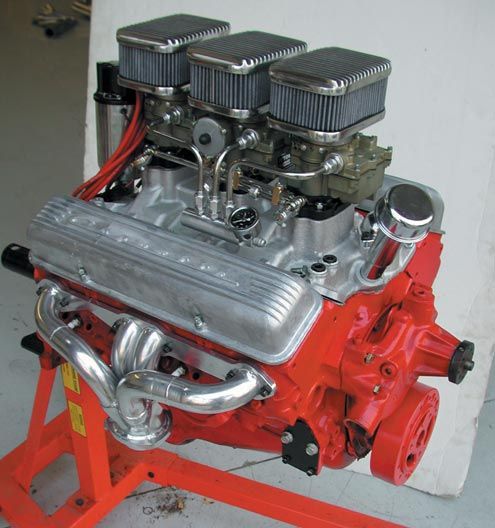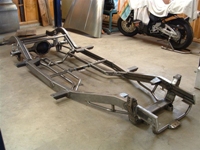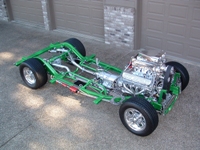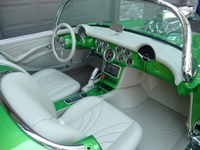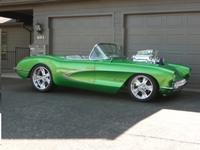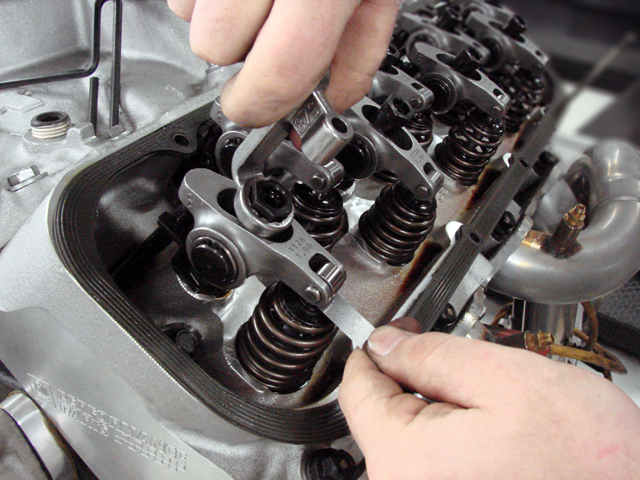Neo-Retro 327 - Modern V-8 Power with 327 Looks
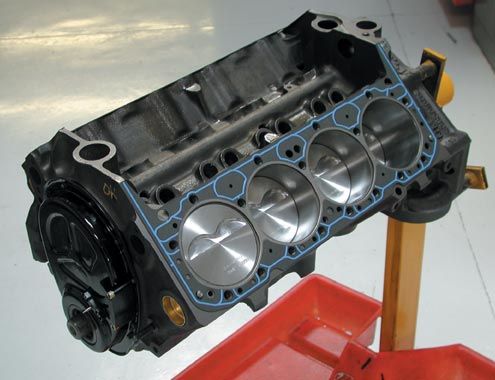
Our retro small-block began as a genuine period-correct piece, right down to the block. It's an early 327, as is evidenced by the provision for the oil-fill tube in the front and the road-draft tube in the rear (pre-PCV). It also has the small-journal, forged-steel crankshaft. Dougan's Engine Rebuilding built the bottom end for us.
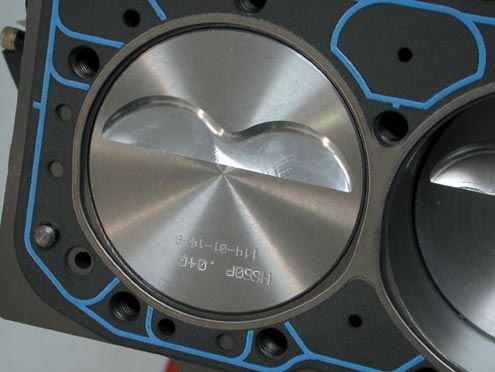
Even a basic rebuild of the short-block can include updates. For example, we had ours fitted with hypereutectic pistons instead of either the basic cast versions used in standard factory small-blocks or the forged slugs found in some high-performance engines. Both are available, but the hypereutectic found in nearly all factory-produced engines manufactured today offers more strength than a cast piston and can be fitted to the cylinder walls with close tolerances due to its minor thermal-expansion rate. Forged pistons, though stronger, expand more than cast or hypereutectic slugs, and therefore must be installed with more clearance; this often results in noisy operation, particularly during cold starts.
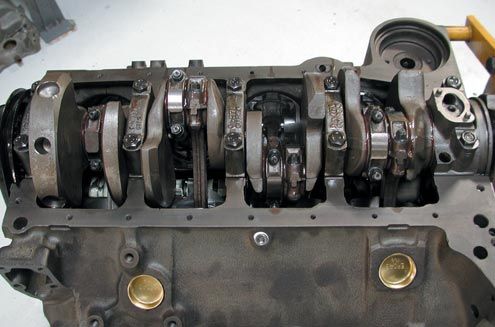
A simple, yet effective means of strengthening the bottom end of the engine is to upgrade the fasteners to high-performance pieces. Even when using performance fasteners to replace the rod bolts in the stock connecting rods, durability increases substantially. Just make sure to have the rods resized after being fitted with the new fasteners. Main cap fasteners can be upgraded as well. ARP offers a full line of bolts, nuts, and studs for a variety of applications. Because we didn't specify, our short-block was built with stock fasteners.
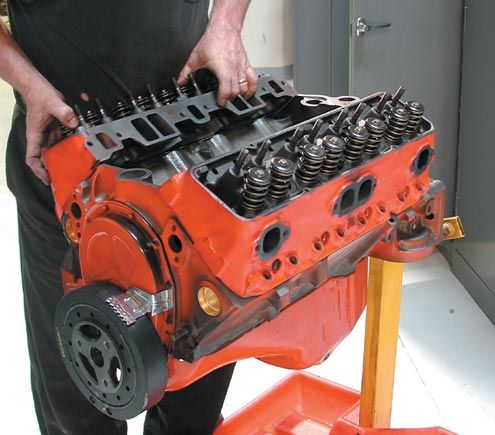
Steve Brule of Westech Performance Group in Mira Loma, California, handled the final assembly of our 327. The cylinder heads we're starting with are 64 Chevy double-hump castings with 64cc combustion chambers and 1.94/1.50-inch valves. We had them checked and rebuilt by JMS Racing Engines in Monrovia, California; this included the valve-spring upgrade and a conversion to modern positive-control valve seals. For years, these were the heads to have for a hot small-block, surpassed only by the 2.02/1.60-inch valve versions, often referred to as fuelie heads. With the pistons we're using, compression should be about 10.0:1.
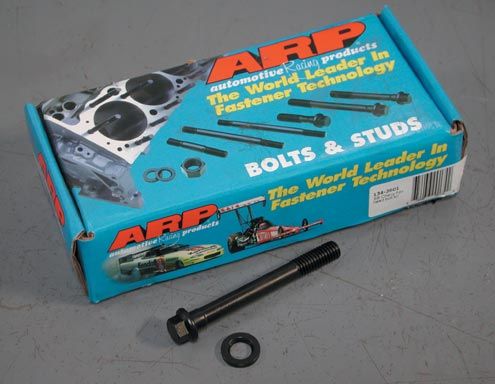
Steve installed the heads with a fresh set of Fel-Pro head gaskets and a set of ARP head bolts. Again, the ARP fasteners are a simple, effective, and, in this case, nearly invisible upgrade.
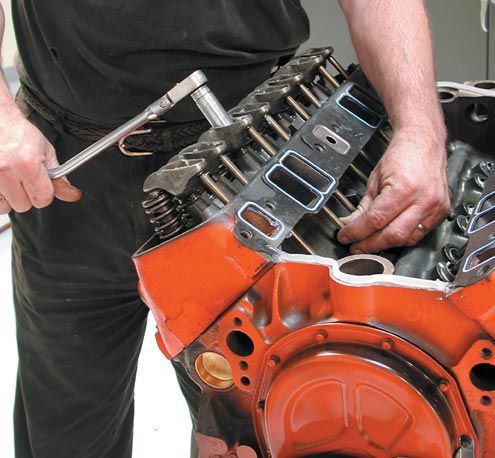
Brule installs the rocker arms and sets the valves. For the first combination, we used stock-type stamped-steel rocker arms, though we chose to go with a fresh set, available from Comp Cams. Well-used rockers are often worn at the tips and at the fulcrum, where the ball stud makes contact. These rockers use the stock 1.5:1 ratio and will work with the Comp Cams flat-tappet hydraulic cam and lifter combo that we had Dougan's install during the short-block rebuild. The cam is a replacement grind for the old L-79 327ci/350-horse engine (222-degree duration at 0.050-inch lift, 0.447-inch lift).
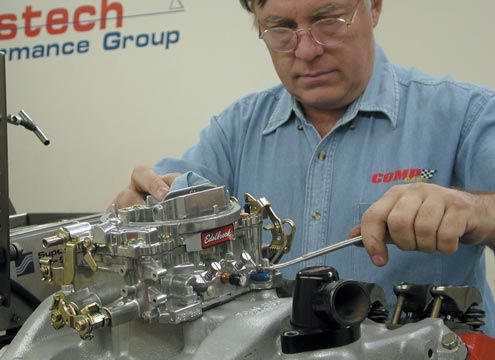
Westech's John Baechtel tops the engine with a 64 cast-iron four-barrel intake manifold, originally installed on a 300hp 327 from a 64 Corvette. Again, this is standard performance fare for an early-60s small-block. The intake is then fitted with an Edelbrock Performer 625-cfm carb. The Performer is available brand-new but is dimensionally similar to the Carter carbs originally used with this intake, in fact, this is one of the few applications that requires the use of the inside mounting holes on the carb feet.
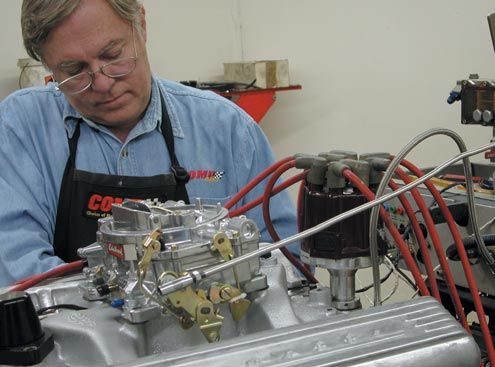
For the dyno-testing, we're using an MSD Pro-Billet distributor. Although it's a race-quality electronic unit, it uses a breaker-point-style GM cap, giving it the ability to blend in with the early appearance of the motor. For absolute early appearance, the billet housing could be refinished to look more like a stock GM housing.
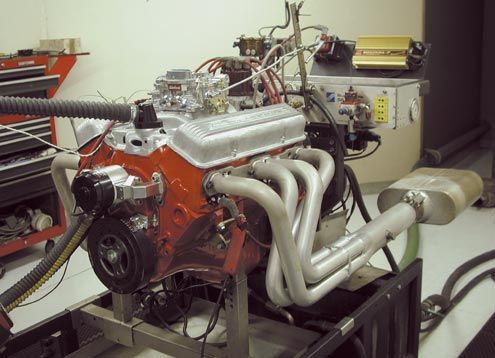
Our 327 was finished off with a set of early Corvette aluminum valve covers, still available from GM Performance Parts. Non-nostalgia items necessary for the dyno test included a set of Sprint Car style headers, an electric water pump, and a large late-model-style balancer. In this trim, the 327 generated 300 hp at 5,400 rpm. At 3,500 rpm, where the pull began, torque was 356 lb-ft but had already passed its peak.
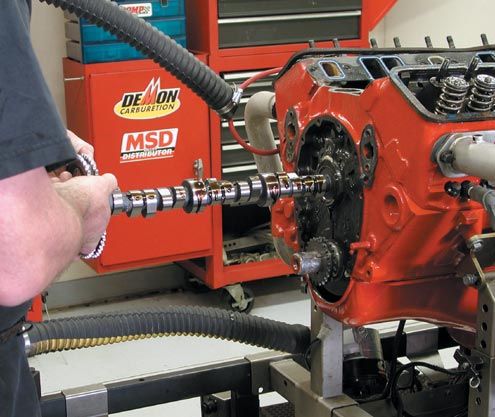
Next, it was time to upgrade the camshaft. Cam swaps are a common part of hot rodding, and our 350-horse factory grind, though respected in the 60s, is actually rather tame. Instead of simply swapping in a bigger cam, though, we used the opportunity to take advantage of roller-cam technology. True, rollers existed in the 60s, but they were solid-lifter designs intended for racing.
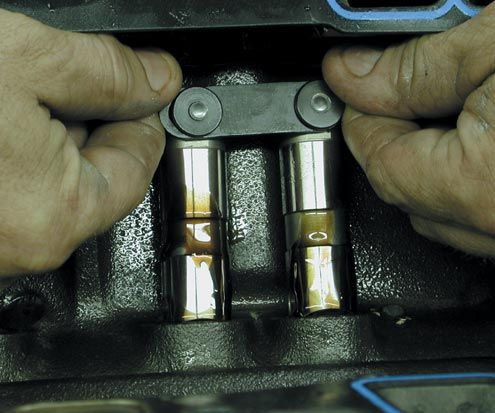
Our Comp Cams Xtreme Energy 282HR-10 cam kit uses a steel roller cam and roller hydraulic lifters. The lifters are designed to drop into any small-block and are aligned with a tie bar linking each intake/exhaust pair. The roller design doesn't simply reduce friction; it also allows more flexibility in profile design. The grind features 230/236 degrees duration (intake/exhaust) at 0.050-inch lift and 0.510/0.520-inch lift on a 110-degree lobe separation angle.
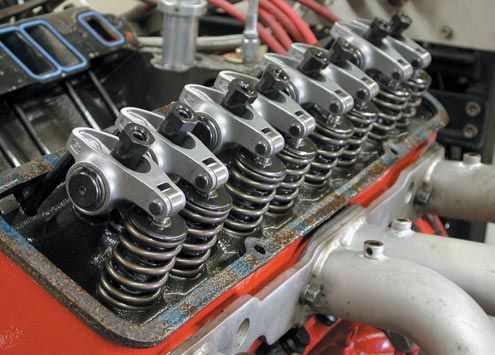
While we were at it, we also installed a set of Comp's Pro Magnum roller rocker arms. These rockers have rollers at the valve tip and the fulcrum to reduce friction, and the chrome-moly steel construction reduces flexing. We used 1.52:1 ratio, though 1.6:1 is also available to further increase net cam lift. We swapped valve covers to taller aftermarket pieces because we needed a breather provision, but the Pro Magnum rockers should fit under the Corvette covers, though other short covers with baffling may not have enough clearance.
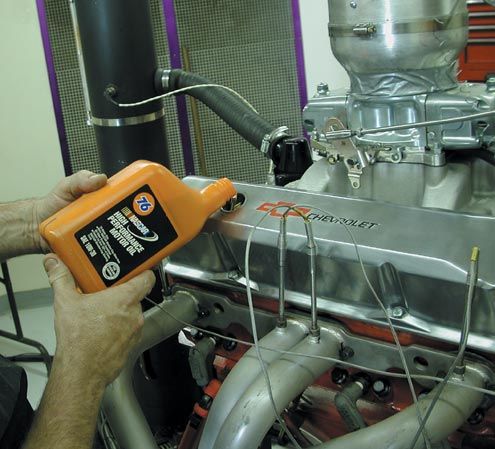
Brule fills the crankcase with fresh Unocal 76 10W30 oil before making the next round of pulls. Moments later, the 327 made a whopping 396 hp at 6,000 rpm and 392 lb-ft at 4,500 rpm. Even at 3,000 rpm, where the pull began, the engine was already making 370 lb-ft. Idle quality was choppy, but we could still pull it down to 800 rpm. A street rod with this cam would sound very healthy and still have enough vacuum to power a brake booster.
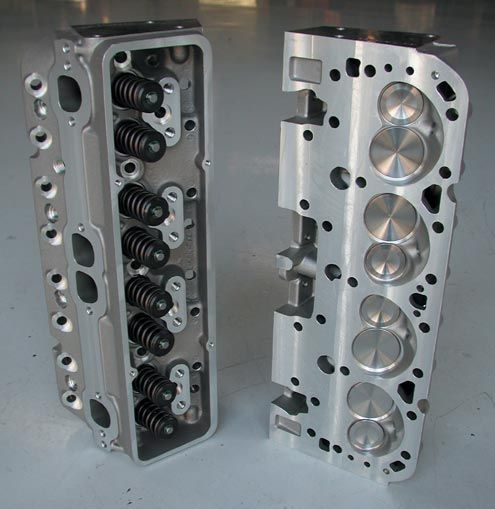
Next, we pulled out the big guns. Many engine builders agree that the key to horsepower lies in the cylinder heads, and ours were nearly 40 years old in design. We decided to step up to modern technology and procured a set of Trick Flow aluminum 23-degree heads. These are available through Summit Racing, and feature 2.02/1.60-inch stainless valves and 64cc combustion chambers, along with a modern fast-burn chamber design and high-performance valve springs and retainers. They're ready to go out of the box for $895, including the necessary guide plates, rocker studs, and hardened head-bolt washers. Plus, they accept any traditional small-block intake manifold and perimeter-bolt valve covers. The Trick Flow heads are also available with larger valve springs, CNC-machined chambers, and 72cc chambers.
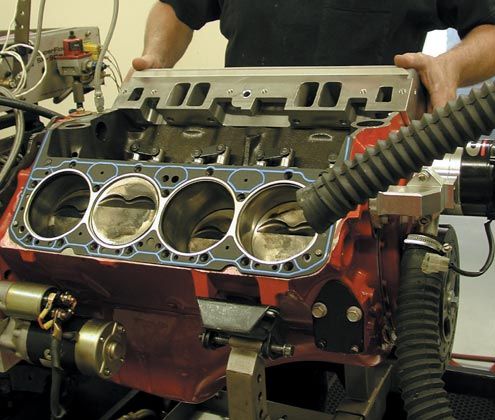
The Trick Flow heads were installed with a fresh set of Fel-Pro gaskets, and the Edelbrock Performer RPM manifold and Demon 750 carb were reinstalled along with the Comp Cams roller rocker arms. With this combination, the engine made 426 hp at 6,100 rpm and 400 lb-ft at 4,600 rpm. At 3,000 rpm, the 327 was grunting out 378 lb-ft of torque enough to shove any rod along at a high rate of acceleration. As a result of the fast-burn combustion chambers, the Trick Flow heads like a little less total timing we ran 34 degrees instead of the 36 used with the Chevy heads. This reduces the need for high-octane fuel, even with higher compression ratios. In fact, all of our tests were performed using Unocal 76 92-octane pump gas without any problems.
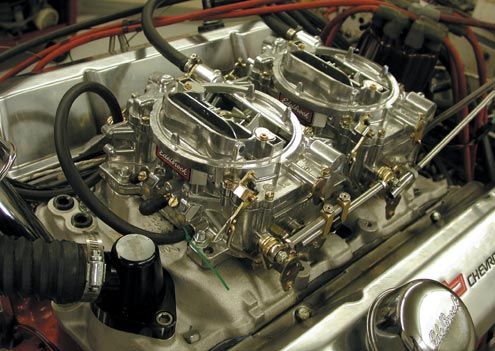
Now that we knew what the 327 was capable of, we decided to try out some old-school induction systems to get the full retro flavor. Our first was a low-rise dual-quad setup from Edelbrock. The manifold is the same one the company offered in the 60s, and we outfitted it with a pair of Edelbrock Performer 500-cfm carbs. Again, the Edelbrock carb's dimensions are similar to the Carters used with this manifold back in the day, so they bolt right on. Edelbrock offers the adjustable linkage, as well.
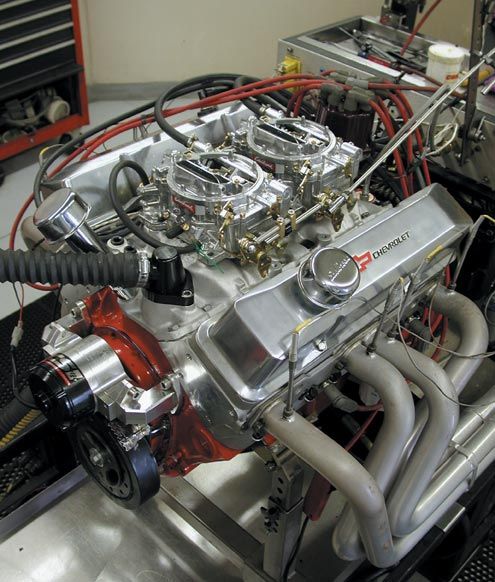
We were impressed to find that the engine made 418 hp at 6,200 rpm and 382 lb-ft at 4,700 rpm with the Edelbrock dual-quad setup, considering that the low-rise 4x2 setup doesn't leave much real estate to optimize runner design. Plus, it was developed decades ago. This induction system offers an excellent mixture of nostalgia and performance.
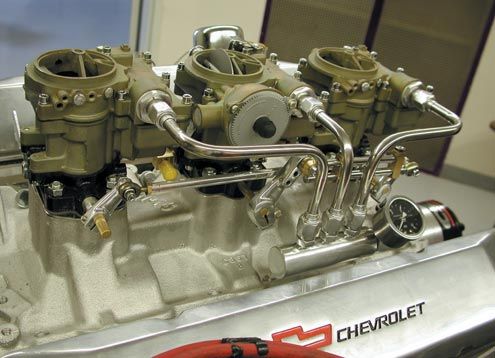
The three two-barrel setup from Automotion is a visual masterpiece. It combines another new casting of a vintage Edelbrock manifold with three reconditioned Rochester carbs that have splined shafts, prebent stainless fuel lines, a pressure gauge, and polished linkage. As promised, the trips fired up and ran smoothly right out of the box, but this particular set had been calibrated for an engine more like our first combination; our heated-up 327 wanted a little more fuel. Brule tuned the carbs for maximum power using jets supplied by Automotion, and the 327 managed to generate 380 hp at 5,500 rpm and 380 lb-ft at 4,900 rpm. Edelbrock states that this manifold is good for up to around 5500 rpm, and right after the 327 crossed this threshold, the power curve leveled off. We felt that for a forty year old design, this was quite good. This is another great-looking system that would run perfectly on the street.
